#fragment deisgn
Explore tagged Tumblr posts
Text

Here we are are with Peach and along with her, a bunch of information about my AU🌟


#The Fragmented Tales#super mario#super mario au#mario au#undertale#undertale au#au#alternate universe#princess peach#my art#digital art#character deisgn#concept art#character art#fanart#artists on tumblr
32 notes
·
View notes
Text
Pigs Eyes & Crying Elephants: Sentient Beings Manifesto
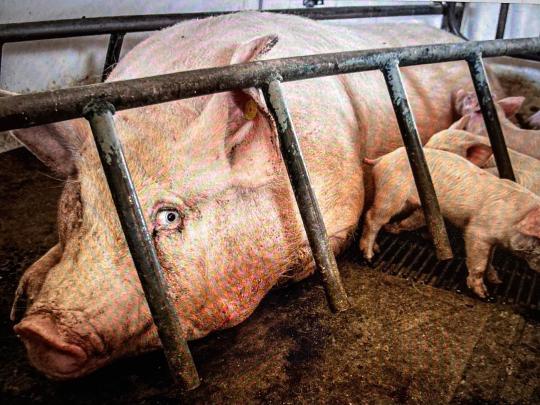
A commercial with a crying elephant & the eyes of a pig.
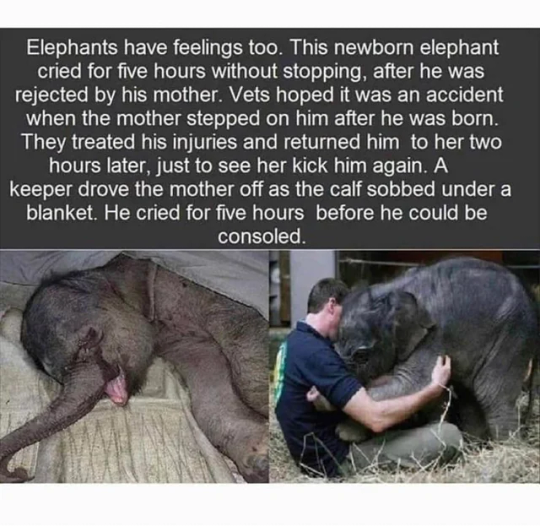
I saw the elephant commercial for an animal welfare group last Tuesday during NXT.
That is what started all of this.
I was vegetarian for two years from 2013 to 2015 meaning I didn't eat any meat or seafood but I did eat eggs & consume dairy.
Then I started eating meat again in 2015.
Then about a year ago, I decided I would eat vegetarian during the week (Monday through Friday) and then eat meat & dairy on the weekends -- so my diet was 75% vegetarian for the past year.
But I was still eating all the chocolate, cheese & all of the dairy tingz.
Then I saw a commercial last week during NXT with a crying elephant. It really got to me.
I started during research on elephants & emotion. Turns out elephants pass the "mirror test" and are self-aware.
So are dolphins.
That led me down a rabbit hole where I started researching the emotional self-awareness of other animals and was surprised to find similar findings for pigs, chickens and cows.
And monkeys -- rhesus macaques are endlessly tortured for human medication. They are extremely self-aware and emotional.
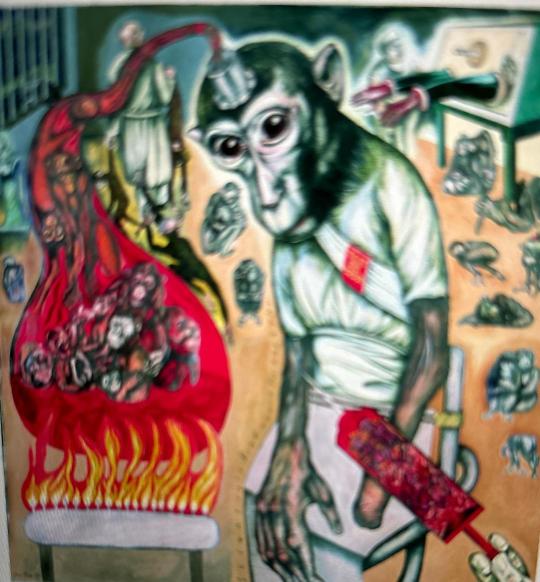
I questioned myself on why my 75% vegetarianism diet shouldn't be 75% plant-based (vegan).
And I realized that I didn't want to give up exactly two things: cheese & chocolate.
And hell no, I didn't want the vegan alternatives.
But I started researching the dairy industry which then led me to researching CAFOs (commercial agricultural feeding operations) aka factory farms aka hell on earth aka infinity mirrors of animals being tortured endlessly.
10 billion land animals are slaughtered every year in the United States. Millions a day.
Is that really necessary?
Then I realized that the dairy industry was the plot to a dystopian sci-fi novel:
Women are forcibly impregnated, their babies taken from them immediately after being born — the baby boys are killed within 1 to 4 days, the girls are imprisoned to be forcibly impregnated just like their mothers.
The impregnation cycle is relentless and there are absolutely no breaks between artificial insemination - impregnation - birth repeat.
The woman are also given artificial growth hormones to force them to grow bigger & more quickly — the easier & quicker to impregnate them.
The women are kept in stalls that are so small & overcrowded they cant even move or turn around.
The women never see natural sunlight.
They are only allowed out of their stalls to give birth.
They are forced to endlessly lactate and pumped by machines so mercilessly that they bleed.
I still didn't feel that I could give up cheese 75% of the time.
Then I questioned myself on why not.
I have done very restrictive very low calorie diets in the past. I used to work out 2 hours a day, 6 days a week. I used to have a six pack.
I broke my 13 year addiction to the NFL & won't even be watching the Super Bowl once a year as of this year.
Why then is not eating cheese 75% of the time a seeming impossibility?
That was honestly how I felt.
So, I googled and found this:
Cheese contains casein. This is what causes such intense cravings. It also contains casein fragments called casomorphins, a casein-derived morphine-like compound. Dairy protein has opiate molecules built in. When consumed, these fragments attach to the same brain receptors that heroin and other narcotics attach to. Casomorphins cross the blood brain barrier and attach to dopamine receptors.
Cheese is literally 10% as addicting as morphine.
Yet they (do ask yourself who they is) have the motherfucking audacity to say it is "no more addictive than anything else that could be addictive, like Pringles or fast food."
First of all -- they are simply proving the point as those foods -- OPFs or overly processed foods & fast food -- also are highly addicting by deisgn, they are literally made to be. Study after study has confirmed that the most addictive foods are foods that are highly processed, high in fat, high in sodium and/or sugar.
Checks out, right?
What foods do you consider the most addicting?
Probably Oreos, potato chips, pizza, french fries, mozzarella sticks, fast food, donuts, cookies, brownies, pretzels, burgers like anyone else.
Right?
They are designed that way on purpose.
They create addicts on purpose for profit.
Cancer, diabetes, hypertension, high blood pressure, artherosclerosis, blood clots, immune system disorders, heart disease, stroke, heart attacks are all caused by diet & lifestyle.
It is a very lucrative business for them.
A million people are already on Wegovy babes?
It's a set up.
They make the food that makes people sick and they make the medicine that people buy after they buy the food that makes them sick. The above diseases did not exist at the current rate even 100 years ago. It's due to OPFs (overly processed food), PFAs (forever chemicals), toxins, sugar substitutes, partially hydrogenated vegetable oil (transfat), high fructose corn syrup, modified food starch, monosodium glutamate, dextrose, sucralose, lecithin, emulsifiers, aspartame, genetically modified organisms (GMOs), bioengineered ingredients, pesticides, artificial flavors & colors, preservatives, synthetic lab-made chemicals.
Capitalism is nothing but a death cult.
Wake up.
They are literally made that way on purpose & designed to be addictive.
But the way that casein is addictive is truly unique because it is binding itself to receptors in our brains the way that morphine & heroine does.
So, I decided I want to do something that is sustainable in the long-term 15 & 20+ years from now. I am 43.
I don't play an all or nothing zero sum game of zealotry where it's something that is impractical.
I look forward to the weekly meals with my husband.
We have been together for 17 years and have been married for over a decade.
I've looked at thousands of recipes over the years and have curated a Top 100 list of our absolute favorite receipes plus ones that I want us to try.
We always make a meal on the weekend & post the pictures on his Facebook.
While we eat our weekly meal, we talk, hang out, watch stuff on Youtube, baseball, basketball & wrestling.
It's one of the things we look forward to doing together as a couple the most.
He is the quintessential "meat & potatoes��guy" but when I started eating vegetarian 75% of the time last year, he agreed to eat vegetarian 3 to 5 days a week.
He does eat meat & dairy the other days of the week.
I have decided that maintaining our weekly meals ritual as a couple is important to me.
So, for this to be sustainable it has to allow for our weekly meals to have meat and/or dairy -- and also, during the holidays, I want to be able to eat meat and/or dairy.
Other than that, Monday through Friday, my plan for the rest of my life is to eat a vegan (plant-based) diet 75% of the time -- no meat, seafood, dairy or animal-based or derived ingredients or by-products.
I immediately went through my apartment this morning once I had decided on this & was disappointed at how many of my snacks weren't vegan -- Annie's Organic granola bars, Nature's Bakery Bars & literally all of my remaining Halloween candy (Take 5, Reese's Cups, Crunch, & candy corn).
I gave it all to my husband in a bag this morning for him to take to work.
Since they are snacks that I ate on a daily basis, it is better to remove them from the apartment as my goal is to now eat vegan (plant-based) diet 75% of the time, Monday through Friday.
Staring at a bag of my absolute favorite non-vegan candy corn isn't exactly going to help me achieve that.
Vox When asked in an interview on the Climavores podcast why farms aren’t regulated to reduce pollution, USDA Secretary Tom Vilsack said there are simply too many farms to regulate, and that conservation efforts should be voluntary
According to Civil Eats, a nonprofit publication covering the US food system, nearly all animal agriculture operations are exempt from federal protections under the Occupational Safety and Health Administration, and the agency doesn’t respond to 85 percent of worker fatalities on animal farms.
Most states exempt livestock from anti-cruelty laws, and many states have passed “ag-gag laws,” which criminalize activists and journalists for simply recording what goes on at farms.
All 50 states have so-called “right to farm” laws, which prevent citizens from suing farms for nuisances like pollution and odor that degrade their quality of life.
A recent analysis from Stanford University researchers found that from 2014 to 2020, the US livestock sector received about 800 times more public funding than the meat, egg, and dairy alternatives sector.
Farmers are heavily overrepresented in government, with 25 current members of the US House of Representatives, or their family members, having collected millions of dollars in agricultural subsidies. That’s almost 6 percent of the chamber, even though just about 1 percent of Americans live on farms. The dynamic is the same at the state level.
Corn and soybean production, most of which is dedicated to ethanol and livestock feed, accounts for half of all crop cash receipts.
Don't you think some of the children literally starving to death right now in North Gaza in Palestine could have used some of that corn & soybean? No? The livestock that we don't need to eat because we don't need meat to survive needed it more than the children literally dying from starvation right now in North Gaza?
Vox Raising livestock requires far more land and water than growing plant-based foods — and produces far more pollution.
Over the past decade, the animal-agriculture industry has been behind the introduction of "ag-gag" bills in more than half of all state legislatures across the country. These dangerous bills are designed to silence whistleblowers revealing animal abuses on industrial farms. Ag-gag laws currently exist in six states, penalizing whistleblowers who investigate the day-to-day activities of industrial farms, including the recording, possession or distribution of photos, video and/or audio at a farm.
The USDA never conducts surprise audits, or any audits at all, to verify the company is telling the truth. It is, in essence, an honor system. The USDA also has an incredibly low, and often nonsensical, bar for what passes as humane treatment.
Over the course of more than a dozen shifts at multiple Foster Farms facilities, the investigator — who requested anonymity due to the covert nature of undercover investigations — documented workers slamming birds into crates, kicking and hitting chickens, and numerous instances of forklift drivers running over birds.
The investigator recalled making eye contact with a bird shortly after they were run over by a forklift. “They were being crushed and everything was being pushed forward, and they had their beak open, and they had this look on their face like they knew that they were dying,” the investigator told me. “And then I watched them flap and struggle for a moment before passing.”
The investigator chalked up most of the cruelty to the chaotic, fast-paced work environment imposed by supervisors during long, grueling shifts.
But you wouldn’t know that from its marketing or its “American Humane” certification.
Chickens raised for meat in America -- 98% of land animals that get slaughtered each year in factory farms -- are five times bigger today than they were in the 1950s! In 1957, chickens on farms raised for meat were 907 grams. In 1978, chickens on farms raised for meat were 1,808 grams. In 2005, they are 4,202 grams! WHERE IS OUR HUMANITY???????????
Vox American Humane allows for the standard chicken slaughter process: shackling chickens upside down, dunking them in a bath of electrified water to stun them unconscious, slitting their throats, and then placing them in a scalding vat to loosen their feathers.
Despite all that, the resulting meat can still be advertised as humane, sustainable, and produced from healthy birds.
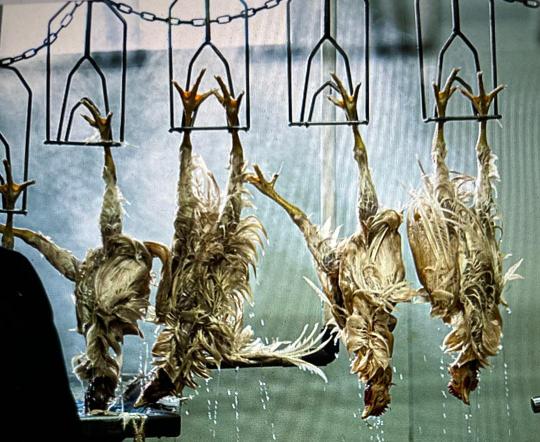
Currently, chickens and other poultry birds have zero federal legal protections while on the farm or in the slaughterhouse.
During their short stint on behalf of the Washington, DC-based animal rights group Animal Outlook, the investigator documented hours upon hours of the typical horrors found on chicken factory farms: tens of thousands of birds stuffed into dark warehouse-sized barns, many of them severely injured with gruesome lesions, injuries, and deformities. At more than one point, birds are deprived of feed or water, and there was also a rat infestation and footage of bugs crawling in the chickens’ feed.
The conditions are visibly at odds with Tyson’s advertising claims that it treats animals humanely and raises “happy” and “healthy” chickens.
“It’s just a living nightmare,” the investigator, who requested anonymity due to the covert nature of undercover investigations, told Vox. “A video just does not do it any justice.”
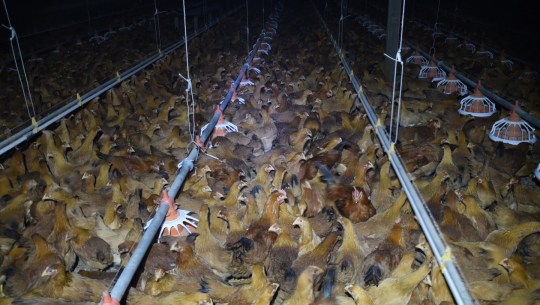
Despite the horrific findings, they’re not all that different from the conditions documented at other farms that raise chickens for Tyson and Tyson’s competitors. The US Department of Agriculture (USDA) says chicken producers using the label “free-range” must provide birds “continuous, free access to the outside” for over 51 percent of their 6.5-week lives.
Is 6.5 weeks a life?????????????????????
In another portion of Animal Outlook’s footage, when the investigator asked the farm manager why so many chickens couldn’t move, he was blunt:
“They’re just fucked up.”

According to a 2021 ProPublica investigation, humane-labeled chicken is often processed in the same slaughterhouses, owned by companies like Tyson, as conventional meat.
“You almost couldn’t design a more torturous setting,” she said, adding that the video shows dying and dead chickens in “advanced states of decomposition” with the potential to “spread infectious disease to the other birds, human workers, and unsuspecting Tyson customers.”
WHERE IS OUR HUMANITY???????????????
Animal Outlook’s investigator also documented bugs crawling in the chickens’ feed, and rat infestations — problems echoed by the Tyson technician in the undercover video.
“The little baby chicks are gonna peck at those bugs, eat them, and then they’re gonna die,” Tyson’s technician told the farm manager in a conversation recorded by the investigator.
“You got rats in there, you got fresh rat activity in all your houses.” Despite these known issues, Animal Outlook alleges Tyson delivered fresh chicks to the farm.
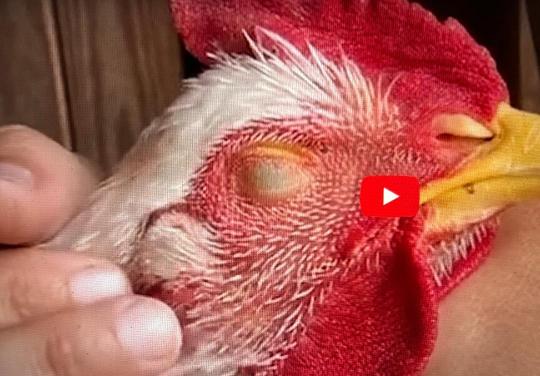
As journalist Eyal Press, author of Dirty Work, a book on jobs in morally troubling industries like poultry, put it in a Vox podcast interview: “On the rare occasions when the curtain is pulled back and we see this dirty work going on, the blame goes to the lowest-ranking people at the bottom, and that’s very convenient for society.”
Ofcourse it is -- society still wants their Wendys Spicy Nuggs.
Vox However, holding meat companies legally accountable for how they treat animals is exceedingly difficult because there are no federal laws that protect animals while on the farm, and birds are exempt from federal slaughter and transport law.
Chickens raised for slaughter are bred in "high stocking densities", meaning they are unable to "move freely to flap their wings" or show "natural behaviors".

"They [Frankenchickens] have been bred to eat at an extraordinary rate so they put on this completely inappropriate weight gain just to get to market as quickly as possible."
If you are a starseed, understand our mission is to break up & dismantle Big Meat & Big Ag (& ofcourse Big Oil, Big Pharma, etc...): LPE Project
Today four massive companies – JBS, Tyson Foods, National Beef, and Cargill – control over 80 percent of America’s beef. Three companies – JBS, Tyson, and Smithfield Foods – control 63 percent of America’s pork. Two of those – JBS and Tyson – also control 38 percent of poultry. The grain, seed, farm equipment, agrochemical, livestock genetics, and animal pharmaceutical industries have likewise become highly consolidated.
These companies possess dominant market power as both sellers of meat and buyers of livestock, which they used to raise prices for consumers and lower prices paid to farmers.
In 1971, President Richard Nixon appointed Earl Butz – who at the time served on multiple agribusiness boards – to lead the USDA, opening a revolving door between the industry and the agency that has swung non-stop ever since.
Under Butz, subsidies for fossil-fuel-intensive monocultures led to a glut of cheap grain, which in turn led to factory farmed animals. “Since factory farms could buy grain for less than it cost farmers to grow it, they could now fatten animals more cheaply than farmers could,” wrote Michael Pollan.
In the last year, top companies in every major American meat sector – beef, pork, chicken, and turkey – have been subject to civil suits and/or federal investigations for conspiring to keep prices high. One lawsuit estimates that chicken industry price-fixing alone costs the average American family of four $330 per year.
The primary reason multinational meat conglomerates have flourished, and meat prices have remained artificially low, is that our government massively subsidizes them at everyone else’s expense.
Our government subsidizes Big Meat directly by allocating the bulk of federal crop subsidies to large farms growing animal feeds, by financing animal factory infrastructure, by buying billions of dollars of their products, and much more. In exchange for this support, taxpayers get hijacked federal agencies, policies shaped by pro-industry academic research, a less responsive democracy, and forceful industry lobbying to keep it that way.
It does this by failing to regulate the environmental impacts of factory farming, including the industry’s role in contaminating air, poisoning drinking water, and driving the climate crisis; by failing to require safe conditions for slaughterhouse workers; by denying most farmworkers the rights to form unions and earn minimum wage and overtime pay; by exempting “common farming practices,” no matter how cruel, from most state animal anti-cruelty statutes; and by failing to restrict the industry’s use of antibiotics (used to speed growth and keep overcrowded animals alive) despite the resulting increase in drug-resistant infections.
Farmer suicide rates are now 3.5 times that of the general population.
It is now commonplace for pigs (and their diseases) to be trucked hundreds of miles across the country without food, water, bedding, protection from extreme temperatures, or adequate space.
BedlamFarm.com One of these happenings was the discovery by scientists in New York in the 1950’sthat by adding tiny traces of antibiotics to animal feed they could increase the growth rates of animals.
With these new tools, farmers could concentrate animals in confined areas on a scale never before possible.
This was soon to be called “factory farming” by the few voices raised in alarm. The term has never been complimentary..
At the same time as the geneticists made their discoveries, Earl Butz, Dwight Eisenhower’s Agriculture Secretary, defined the new future.
It isn’t clear if Butz, a crude by visionary agriculture economist, saw the coming future or created it.
Farms, he said, and farmers had to consolidate, corporatized, embrace economies of scale, just what most family farmers would never do. The economists picked up this cry, and the family farmers never had a chance.
Butz was serious, perhaps prescient. He meant that in order to survive, farmers must pursue a new corporate model for farms – maximize profits, minimize loss.
Corporations jumped into farming big-time, buying giant tractors, hiring biologists and geneticists to redesign animals and turn them into unhealthy freaks with short live spans and no resistance to illness, parasites, or viruses, setting up distributions systems that could even sell milk and meat overseas.
On the corporate farms, when a cow gets sick, it is instantly put to death, veterinary care cut into profits, the cow just goes to slaughter.
The average live span of a milk cow, says the Agriculture Department, plunged from 12-15 years to two years by the 1990s. Cows on corporate farms never set foot outside, some never left their stalls, get no exercise, and are bored almost senseless.
Where is our humanity?????????????????
There is no stimulation in their lives, no change of scenery no hed for these herd animals, no walk, grazing, or hanging out with other cows, a cow’s favorite activity.
They live as long as they can produce more and more milk, and when they can’t, they die.
For animals, life became an Orwellian horror show, their very bodies, and spirits taken from them as they were genetically engineered to be profit centers, not animals with human caretakers and individual personalities and traits.
So have the chickens and pigs, many of whom live their lives without ever standing up in factory farms, mostly in the mid-central United States.
Most Americans will never see what is happening to these animals or even hear about them.
The people who increasingly have taken over the care of the animals we eat are sometimes the cruelest and most immoral people who have ever come within a hundred miles of a farm.
Comment to the above article: A quick google search reveals legislation proposed to add oversight to use of antibiotics in animals in 2018, 2017, 2013, 2002- all fought by Big Pharma. Often with the same ferocity and tactics used by Big Oil to fight against regulations to slow climate change.
ForksOverKnives: The USDA is tasked with setting the nation's nutrition guidelines. Yet this is in direct conflict with its primary interest: ensuring the profitability of producers of foods such as dairy and meat. These foods are known to increase the risk of obesity, diabetes, cancer, and cardiovascular disease. Is it any wonder that programs administered by the USDA and funded by the Farm Bill preferentially feed school children and the poor unhealthy foods that cause chronic disease?
The farming practices that underpin our healthcare crisis also degrade our environment. To grow vast swaths of these monoculture crops, enormous amounts of chemical fertilizers, pesticides, herbicides, and fungicides are required. Many of these agricultural chemicals are suspected endocrine disruptors and carcinogens that are thought to alter human DNA down through the generations.
During my lifetime alone, annual worldwide pesticide production has increased from 200,000 tons to more than 5 million tons, according to estimates from The Food and Agriculture Organization of the United Nations. It has gotten to the point that many of these chemicals now rain down upon us. These pesticides wipe out beneficial and native wildlife such as honey bees, monarch butterflies, and songbirds.
A Happy Meal? If, by eliminating Farm Bill subsidies, the cost of a Quarter Pounder with Cheese were to rise from, say $4 to $15, eating habits would likely shift toward eating healthier foods, especially if at the same time, a program were put in effect to incentivize the consumption of whole plant foods. In fact, a large nationwide program in South Africa has already demonstrated that the public will consume more fruits and vegetables when these healthy foods are subsidized.
Making Us Sick Makes Them Money The 17 percent of GDP (about $3.2 trillion) the nation now spends on health care will rise to 20 percent of GDP by 2025, according to The Center for Medicare and Medicaid Services. The CDC estimates that 86 percent of this money is not actually spent on making people healthy; it is spent on treating and sustaining chronic illness such as cardiovascular disease, cancer, obesity, diabetes, and dementia. The medical evidence shows that most of this chronic disease is the result of the food we eat and can be prevented and even reversed by eating a plant-based diet.
Fish have it worse in one way -- they have ZERO legal protections.
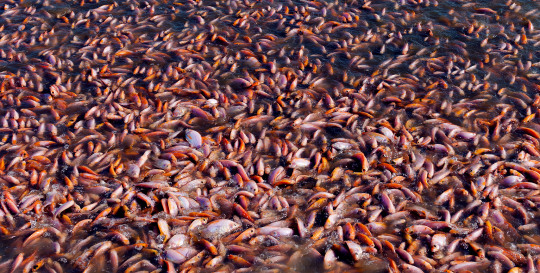
AnimalEquality Commercial fishing is cruelty to animals on a colossal scale, killing nearly a trillion animals worldwide every year. Ships the size of football fields use techniques such as longlining and gill nets.
Gill nets, which range from 300 feet to seven miles in length, create large walls of nets that fish are unable to see. They inadvertently swim into them and many will suffocate or bleed to death.
In the United States, fish are not covered by the Humane Slaughter Act. This results in a wide variety of cruel slaughter methods dependent on industry, company, and species.
Fish are usually removed from the water and left to suffocate and die. They desperately attempt to escape as their gills collapse preventing them from being able to breathe. Larger animals, such as tuna and swordfish, are usually clubbed to death. This often leads to an animal being injured but regaining consciousness and the process having to be repeated several times.
There are 1.3 billion farm raised fish in the United States.
Vox It’s unsurprising that fish have been ignored. They live underwater, so we rarely interact with them. They can’t vocalize or make facial expressions, so it’s much harder to understand them than mammals and birds. And research has shown that the further animals are from us on the evolutionary chain, the less likely we are to try to protect them.
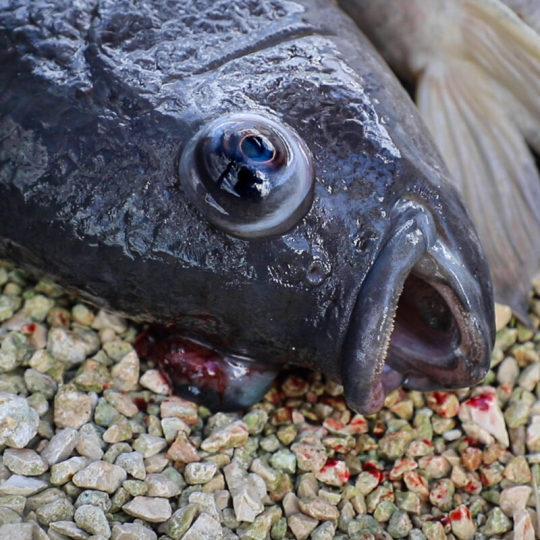
In commercial ocean fishing, the welfare concerns are mostly relegated to the final minutes or hours of a fish’s life — they’re typically left to suffocate to death on deck, which can take under an hour or up to several hours.
Other welfare issues include rough handling and the inability to express natural behaviors, like migration and nesting.
One of the bigger findings of the past two decades has been that fish have nociceptors, sensory neurons that detect and respond to damaging or threatening stimuli — a strong indicator they experience pain.
But just like with other species, researchers have repeatedly demonstrated that fish behave differently in adverse conditions (for example, they limit eating and activity) and stop these behaviors when pain relief is given.
They don't WANT to believe fish feel pain because it will lower their profits -- read the above again & honestly tell me that those fish don't sound like they were in pain & then relieved from pain -- so should they be left alone on ship decks to suffocate to death for HOURS???????????

Wild-captured fish experience agonizing final moments no animal should have to endure, as pressure weighs on their bodies when they’re quickly pulled up out of the ocean’s depths in nets, and they begin to suffocate.
Death, too, is cruel on fish farms, where many fish are killed slowly by suffocation or in ice water.
Existing in these cramped environments is a far cry from the lives fish would experience in their natural habitats. For one example, salmon may swim spans of hundreds of miles to reach the ocean from the streams in which they hatched, and much farther as they reach feeding grounds, according to the U.S. Geological Survey. Sometimes, salmon will spend years at sea before returning to their original stream to spawn.
Extraction of groundwater for aquaculture has been found in one study to accelerate sea level rise by causing land to sink.
Pigs on factory farms are often cannibalized, forced to eat meat from fellow pigs.
WHERE IS OUR HUMANITY???????????
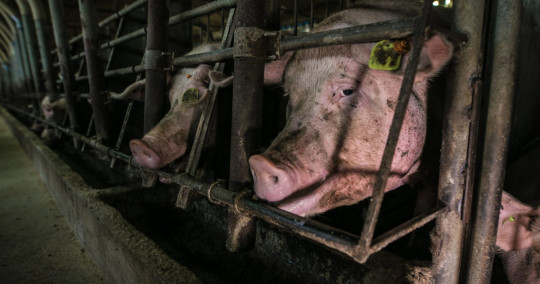
Where is humanity?
They are sentient beings: capable of feeling pain, and experiencing a range of emotions. Scientific evidence has revealed that fish are far more intelligent than people assume. They have long-term memories, complex social structures, problem solving abilities, and some have been seen using tools.
Fish are even crushed to death & literally cut in half while alive!
Where is humanity?
Porkopolis It is near impossible in the industry to encounter a conceptual or ethical limit proposed for sows biological reproductive capacity.
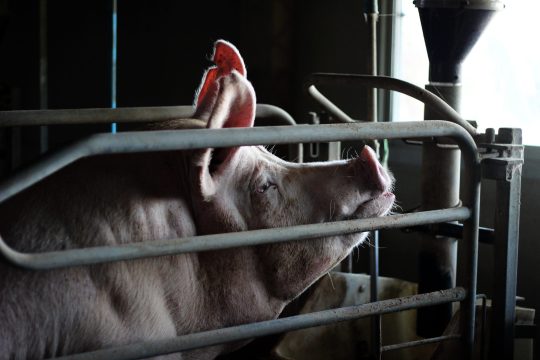
AnimalsAustralia Farrowing crates are cold, hard metal cages with steel or concrete floors. In factory farms around the world, it’s standard practice to transfer mother pigs to a farrowing crate 7-14 days before she gives birth to her new piglets. After birthing (in a process known as ‘farrowing’), she remains confined in these metal ‘maternity’ crates for 3-4 weeks until her piglets are weaned.
Farrowing crates are so small a mother pig can barely move – she can only sit, stand or lay down slowly, and with difficulty. Pigs are naturally very clean animals, and when given the choice, never toilet where they eat, sleep or play. Instead, they will often travel far away to relieve themselves. But trapped in a farrowing crate, she can only take one step forward or back and is forced to urinate and defecate right where she stands. For mother pigs, this unhygienic behaviour causes her extreme stress, discomfort and heightens her risk of disease.
Despite having the intelligence of a 3-year old child, who can solve puzzles and even play video games, have amazing memories, can sense the passing of time, foster lifelong friendships with other pigs and expresses empathy for humans and pigs alike, these loving animals continue to be industrialised and treated like 'products', rather than individuals who feel - and express - an enormous range of emotions. She is someone, not something.
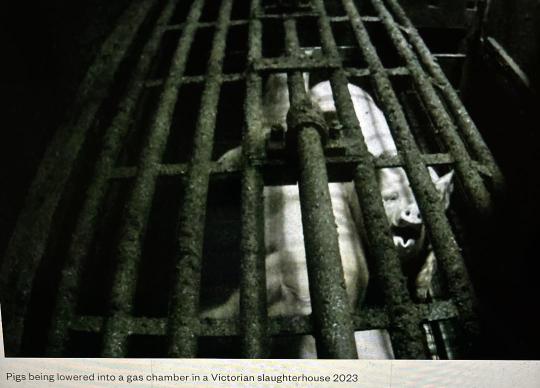
Eggs are Not Eggscellent Cages are extremely cruel, and sadly they are just one of many cruelties chickens are forced to endure in the egg industry. In all commercial egg systems – cage, barn-raised, free-range or organic – male chicks are considered ‘worthless’ and are killed on their first day of life.
Female chicks are raised to replace hens who are sent to slaughter at just 18-30 months old — a fraction of their natural lifespan. As newborns, the tips of their beaks can be cut off without pain reliefto reduce aggressive pecking fueled by frustration when they cannot move freely, forage, or establish a natural social structure.
Because the males bred into the industry won’t grow up to produce eggs they are ‘disposed of’ by gassing or maceration -- literally being shredded to death while alive.
And later that year, at Sparboe Farms in Iowa, undercover investigators documented hens with gaping, untreated wounds laying eggs in cramped conditions among decaying corpses.
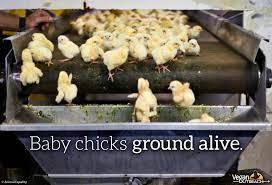
Leo Tolstoy - 1891 Essay A village pig is dragged outside for slaughter. The animals “human-looking pink body” screamed in a “dreadful voice, resembling the shriek of a man”.
After the screams subsided and the animal was killed, even the gruff carriage driver accompanying Tolstoy lets out a heavy sigh.
“Do people really not have to answer for such things?”
Almost 200 years later, do they answer for such things?
My question to anyone reading this (unless you are already a strict vegan) is:
What can you do to reduce the overall suffering & harm done to sentient beings (all animals including fish & cetaceans) that is realistic & repeatable over the long term?
Me, personally I do not see the point in being some total zealot that never eats anyhing with bone char again if it isn't sustainable over the long term.
Vegans call it doing what is "practical & possible".
I believe it is also very important that it be sustainable over the long term or else what was the point?
Now, I will end this by asking you the same question I asked myself:
What can you do to reduce the suffering & harm to sentient beings (all animals including fish & cetaceans) that fits the following two criteria:
Realistic
Repeatable over the long term
I also want to say this if you are a starseed reading this -- we need to work with everyone.
This isn't some kind of ideological purity test or a flex as I see a lot of that within the movement for animal rights & activism. This is about sentient, self-aware beings that are emotional, social & cognitively functional getting the living shit tortured out of them.
This is about the fact that 90% of the world's population as of today eats meat.
This is about 10 billion farm animals being slaughtered in the US every year for food.
This is about 99% of farm animals in the US being killed in factory farms.
This is about 90% of the 10 billion farm animals being slaughtered in the US being chickens.
This is about fedral subsidies that make a cheeseburger $4 when it should really be at least $15.
This is about big meat & big ag spending tens of millions every year to bankroll politicians for favorable policies.
This is about landmark legislation from the EPA & Congress not applying to the agricultural industry that causes the majority of land, air & water pollution & waste.
This is about the fact that there is no Big Broccoli to counter the meat & agricultural cartels.
This is about Trump winning.
It's not about fighting over bone char, cholecalciferol & cross contamination.
It's not about a competition on who can utilize the least animal byproducts (like the paint on the walls in your home & the tires in your car).
It's not a who's the best vegan dick measuring contest.
We need to work with everyone given what we are about against.
The 10 billion number has not dropped. And actually, people are consuming more meat.
Although there have been legislative wins and imitation meat like Impossible & Beyond Meat are promising.
They have the lobbying machine, political apparatus, laws, subsidies & constant commercials & ads on their side. When's the last time you saw a commercial for vegetables?
Now, when's the last time you saw a commercial for Sonics, Dominos, Pizza Hut, Burger King, Pringles, Lays, Reeses Cup, Snickers, Twix, Applebees, Chilis, McDonalds.
We need to work with omnis, flexitarians, pescatarians, people that don't eat pork, people that don't eat chicken, people that don't eat beef, people that don't consume dairy.
That's not watering down or diluting a message.
It's decentering zealotry so we can actually get somewhere in our fight for animals to be recognized as sentient beings with their own inalienable rights.
That is maybe 100 to 250+ years off.
We won't get anywhere if we stay on reddit debating about whether brown sugar is okay if it is processed with bone char.
Keep that in mind. The animals are counting on us. ✨✨✨

#vegan#veganism#antispeciesism#speciesism#big meat#big ag#trump#antispeciesist#vegetarian#animal liberation#go vegan#plant based#flexitarian#omnivore#factory farming#fast food#mcdonalds#kfc#burger king#pizza hut#corporatism#anti capitalism#climate change#starseed#starseeds
26 notes
·
View notes
Photo

Heartless Cards - Enter the Gungeon SHADLET: When the Gundead falls into darkness, the shadows take over. The Shadlet is a small Bullet Kin designed to be extremely similiar to the base Bullet Kin seen in Enter the Gungeon, with heavy inspirations from the Shadow Heartless. The name is simply a combination of Shadow and Bullet. AMMO ANTHEM: Sing the song of Guns reloading! The Ammo Anthem is the Darkness in a Gun Conjurer, designed after the musical themed magic Heartless with implementations of the Conjurer's robes. The name comes from Ammunition and Anthem. FRAGGER: The Fragger is an explosive Heartless that has one goal: To blow up. It is designed after grenades of course. taking ques from the Pinhead Gundead and the Minute Bomb Heartless.. The name comes from the nick name for Fragmentation Grenades, or Frags. GUN CALIBUR: The Gun Calibur is a fusion of the Gun Nut Gundead and the Armored Knight Heartless. The name is a double pun: The calibur of bullet and the famous Excalibur sword! TANKYU: The Tankyu is a more custom Heartless, with inspiration from the Hot Rod type. Designed after a Tank, this small bit of Darkness packs a powerful punch! The name is a bastardization of "Thank you". MAD GUN AND THE CHAMBERED: The custom Heartless boss, the Mad Gun and the Chambered! This dual Heartless is deisgned to be a weapon wielded by the High Dragun. Shooting out the Chambered as bullets to hit their targets! The Chambered are then designed to return to the Gun! Also, the Mad Gun is can fire without a wielder! Once the Dragun is defeated, you still have to contend with the trigger happy Mad Gun!! That is it for the Enter the Gungeon Heartless! This is a bit new to me, so please let me know if you want to see more! And Stay Tuned for the next one!
20 notes
·
View notes
Link
歡迎在留言板交流互動
聯名款,代表著限量與新鮮元素。它,蘊含著每一個品牌帶著其獨特的風格與另一個品牌風格之間的融合與碰撞,在融合的過程中展現出新的生命力,從而衍生出新的作品。每一次聯名都讓人無限期待!但是在這個品牌之間互動頻繁,動不動就聯名合作的時代,會有哪些聯名的作品最讓人留下深刻印象呢?接下來就讓我們一起來盤點一下2017年火爆的各路聯名款鞋子吧。
第一款:耐克/Nike Hyperdunk x OFF WHITE OW 聯名
采用了該系列鞋款一貫的設計風格,幾乎純白的鞋款上點綴了黑色和橙/紅色,以此構成配色主題,“FOAM”字樣出現在中底側面,鞋舌處的倒Nike Swoosh也頗值得玩味,最為顯眼的莫過於Flyknit鞋面上增加的綁帶設計——我們有理由相信其靈感源於Sock Dart,其半透明的視覺效果用以呼應主題——「GHOSTING( 重影)」
第二款:耐克/ NikeLab Air Presto Mid x ACRONYM®
由德國時尚單位 ACRONYM® 攜手著名藝術家 Kostas Seremetis 與 Nike 聯合打造的 ACRONYM® x NikeLab Air Presto Mid 近期引起了鞋迷們的強烈關注。本次三方聯名以 Air Presto 為藍本,融入 ACRONYM® 獨具匠心的機能設定,為這雙經典鞋款註入了全新活力。
第三款:彪馬/PUMA x HAN KJØBENHAVN 聯名款
PUMA攜手HAN KJØBENHAVN為經典鞋型註入當代風格,將運動與時尚以多種材質進行無縫融合。創意總監Jannik通過為這款聯名鞋款打造獨特的縫線設計重塑經典鞋型,使其呈現煥然一新的感覺。運用經典鞋款Clyde,高檔皮革鞋面以手工縫制的方式與鞋底結合,突出了精巧的斯堪的納維亞風。此次Clyde聯名鞋款的設計著重突出精致簡約的風格,PUMA x HAN KJØBENHAVN聯名字樣僅在鞋側處可���,充分表現北歐經典設計。
第四款:耐克Nike與加拿大潮牌Reigning Champ聯合推出AirForce1空軍一號
加拿大街頭潮牌Reigning Champ首次與Nike聯名打造的Air Force 1,鞋子整體以 Reigning Champ 風格的簡約灰色調貫穿,側後方印有RC品牌獨特的Logo配有 3M 反光,整鞋采用極具質感的麂皮材料,
第五款:阿迪達斯/OFF-WHITE × Adidas Originals NMD City Sock
該款聯名款在adidas Originals NMD輪廓上,設計拉鏈閉合模式賦予白色 Primeknit 織物鞋面當中,OFF-WHITE 標志LOGO腰帶分別設計在鞋舌與鞋領,而鞋面上采用透明分別註入三杠LOG與OFF-WHITE標志塑料吊牌,增加品牌聯名的專屬特性。
第六款:喬丹/Kaws X Air Jordan IV 聯名款
很多人說這雙鞋子的設計太過於簡單了,但是每個人的品味都不一樣吧。圖案,象征性的logo,夜光鞋底都讓鞋子增加了與眾不同的感受。重點的是,球鞋將Nike Air 字樣,換成了XX Air。這是典型的Kaws風格。當一切的元素結合在一起,是什麼讓這雙球鞋變成為經典的作品,是Jordan Brand選擇了一雙最好的款式之一,讓這雙鞋子變得更加的藝術,更有故事性。
第七款:喬丹一代/ Fragment Deisgn x Air Jordan 1 聯名
這雙鞋給人一種明明很熟悉但又無限新鮮感的特別感受。經典的AJ1三色以簡潔的方式搭配,鞋身以白色為背景,鞋頭采用黑色打造,後跟和鞋幫則包裹深藍色,經典的閃電 Logo 則體現了它的專屬聯名身份。
第八款:巴黎世家/Supreme x Balenciaga 聯名款
一般來說聯名款會拿點與眾不同或者吸引人眼球的東西來,感覺這款合作款是滿滿的敷衍,貼上個標簽就算聯名款了。
第九款:萬斯/VANS Authentic/Oldskool Platform
風靡全球的Platform鞋型 加上松糕底增高,復古帆布外形 ,極適合夏秋交叉之際使用 , 既體驗了經典美式復古,又不隨波逐流 和路人他款區分,又有這增高的效果。
第十款:阿迪達斯/NEIGHBORHOOD X adidas Originals NMD R1 戰無不勝
日本街頭潮流品牌 NEIGHBORHOOD 與 adidas Originals 這對好基友,素來保持著���好的合作關系,而早前曝光的那雙牙齒細節 NMD R1 還為得到官方正式發布,知名爆料團體 Yeezy Mafia 就又釋出一款全新配色的 NMD 聯名鞋款,再次讓我們感受到被這兩大劇透支配的恐懼!鞋款依然沿襲 NMD R1 鞋型,配色采用 NBHD 獨步天下的黑白雙色營造,鞋側三線以黑色虎紋點綴。後跟虎頭與 “福” 字格外醒目,鞋提和鞋墊上刻畫的 “紀念續福” 與 “Invicible” (無敵) 字樣也彰顯出 NBHD 一貫的暗黑氣質。
0 notes
Text
The Dutch Design Week is the largest design event of North Europe and I went there in Eindhoven for the second year in a row, thanks to a contact with DDW Press office who helped me in the trip.
This time I understood why I love the Dutch Design Week so much. It is a design event without all those frills of the various design weeks, starting from the Milan one . In Eindhoven there is nothing fashion and no ages. Just people of all (and say, all) ages enjoying a cultural event , starting from children and ending with elderlies…and a massive admount of nice cafes, cute corners, places where to eat something. Nobody in a rush here.
In the Dutch Design Week design is culture, history, is helping the environment and the society, before then selling products. It’s research on materials and on fundations, more than on appearance.
That’s why my second article from the DDW focuses on new studies and innovations on materials. Take note!
.
[ITA]
La Dutch Design Week è l’evento più grande di design del Nord Europa e per il secondo anno mi sono recata ad Eindhoven, grazie a un contatto con l’ufficio stampa che mi ha sopportata nella trasferta.
Questa volta ho capito perché la Dutch Design Week mi piace così tanto. E’ un evento di design senza i fronzoli mondani delle varie deisgn week, a cominciare da quella di Milano (che certo, resta sempre la numero uno, eh). In pratica a Eindhoven non ci sono mode, non ci sono età. Solamente persone di tutte (e dico, tutte) le età che partecipano ad un evento culturale. Ci sono ovunque caffé e angoli super cosy in cui bere un caffè, un tè caldo e un dolce, e la gente non va di fretta.
Alla Dutch Design Week il design è cultura, è storia del design, è studio, è mezzo per aiutare l’ambiente. E’ ricerca su materiali e principi, prima ancora che sull’aspetto delle cose.
Per questo oggi vi propongo una carrellata di novità proprio sul tema materiali e sostenibilità. enjoy!
.
[symple_divider style=”dashed” margin_top=”20″ margin_bottom=”20″]
10 new Materials from the Dutch Design Week 2017
[symple_divider style=”dashed” margin_top=”20″ margin_bottom=”20″]
1# STUDIO Mieke Meijer | Formworks
Slipcasting is a technique for the production of ceramics. A liquid clay body slip is poured into plaster moulds and allowed to form a layer, the cast, on the inside walls of the mould. Studio Mieke Meijer constructed moulds from plasterboard, by doing so the object texture appears that reminds of board-formed concrete walls.
[symple_divider style=”dashed” margin_top=”20″ margin_bottom=”20″] #2 Jessica den Hartog | Recolored
The industry recycles the plastic HDPE to the color gray, a neutral color,and to very limiting color. This work is a study around the possibilities of recycled plastic, originating from experiments with material, color and technique. The research serves as a library of colors and materials in a never ending process to recycle plastic.
[symple_divider style=”dashed” margin_top=”20″ margin_bottom=”20″]
#3 Firewall | Bekkering Adams
‘Firewall’ combines the already known characteristics of concrete with the new possibilities of 3D-concrete printing. The concrete material is naturally strong, has a great freedom and by its mass a large accumulation capacity. With the 3D-concrete printing an even greater freedom of form can be achieved.
[symple_divider style=”dashed” margin_top=”20″ margin_bottom=”20″]
#4 Happy Concrete | Iwan Pol
Why concrete has to be gray? Pol experimented with different pigments and various casting techniques, from latex sheets to silicone molds, to create a new look for the concrete.
[symple_divider style=”dashed” margin_top=”20″ margin_bottom=”20″]
#5 Bottle Brick | Lou Van Reemst
Currently 2% of the incoming volume of waste glass is used for the creation of the bottle-up products. For the other 98% the bottle | brick could be a great solution. Lou’s results have shown positive results on the creation of an ASR immune building block that withholds 35% aggregate replacement with waste glass cullet. Fragments can also be incorporated in another material, the Trending Terrazzo.
[symple_divider style=”dashed” margin_top=”20″ margin_bottom=”20″]
#6 WATERSCHATTEN | Studio Nienke Hoogvliet
Nienke Hoogvliet developed a series of objects created with reclaimed and recycled toilet paper. The project was developed in partnership with the Dutch Water Authorities, which has been experimenting with recovering energy and raw materials from waste water: used toilet paper can be collected from the water rather than being burned, as it was in the past. They estimates that 180,000 tonnes of toilet paper is flushed down Dutch toilets each year.
[symple_divider style=”dashed” margin_top=”20″ margin_bottom=”20″]
#7 Air Ink printed scarves | Kelly Gijsen
Kelly Gijsen created scarfs printed with a special ink made of air pollution. The Graviky Labs – an Indian startup made by students – captured pollution into high grade inks called “Air ink”: AIR-INK is the first ink made entirely out of air pollution.
[symple_divider style=”dashed” margin_top=”20″ margin_bottom=”20″]
#8 Marble Salts | Roxane Lahidji
With ‘Marbled Salts’, the DAE graduate Roxane Lahidji reinvented salt as a sustainable design material. She makes use of its unique physical properties as a self-binding composite to create a set of tables and stools. She mixed salt with tree resin, giving it shape and strength and creating with it a set of tables and stools.
[symple_divider style=”dashed” margin_top=”20″ margin_bottom=”20″]
#9 Oesterplat | Marjolein Stappers
Marjolein Stappers , a DAE graduate, investigated how oysters shells can be reused after thrown away as garbage and she came up with the idea for Oesterplat. The result is an elegant tile collection made of concrete, marble and oyster shells.
[symple_divider style=”dashed” margin_top=”20″ margin_bottom=”20″]
#10 Lithoplast | Shahar Livne
Shahar Livne, a DAE graduate, created a clay-like material using discarded plastic: she layered the plastic with minestone and marble dust, two byproducts from the coal mining and stone masonry industries, which are usually discarded.
[symple_divider style=”dashed” margin_top=”20″ margin_bottom=”20″]
More on Dutch Design Week 2017:
8 Design Finds from the Design Academy Graduation Show 2017
DUTCH DESIGN WEEK 2017 | 10 groundbreaking New Materials to help environment and design The Dutch Design Week is the largest design event of North Europe and I went there in Eindhoven for the second year in a row, thanks to a contact with DDW Press office who helped me in the trip.
0 notes
Text
There are moments in the “Measure for Measure” by experimental theater company Elevator Repair Service at the Public that offer the purest Shakespeare on any New York stage; this occurs when they project the Bard’s words on the backdrop as the performers are reciting them. But even here, it’s only when an entire verse is projected, and scrolls up slowly, that there’s clarity. Most of the time, the projected words are scattered, fragmented, overly large, scrolling up at great speed, all of which renders the text unreadable.
The scrolling word play feels like a metaphor for this avant-garde production of Shakespeare’s last comedy as a whole: It’s hard to read. There are watchable moments, occasional visual appeal in the design, even some touching scenes. But it’s difficult to figure out – or appreciate — what director John Collins is up to.
This is the first time in the 26 years since Collins founded Elevator Repair Service (reportedly named after the occupation he was told to pursue by a vocational counselor) that the ensemble is staging a play by William Shakespeare. In a program note, Collins claims that “Measure for Measure,” with its mix of “tragedy and comedy, heartbreak and absurdity creates exactly the sort of environment in which we love to play.” On the other hand, he adds, “Shakespeare’s densely layered metaphors and dizzying grammatical constructions can’t possibly be thoroughly understood and processed in real-time by any but the Elizabethan scholar. But maybe that doesn’t matter.” What makes the play “timeless,” Collins writes, is the “music” of the sentences — not, in other words, their meaning.
To me, this “Measure for Measure” counts as a missed opportunity, given the play’s startling relevance in the age of Mike Pence and Harvey Weinstein. Yes,
even Elizabethan scholars label “Measure for Measure” one of Shakespeare’s problem plays, though not because of the language. It has an odd, convoluted plot, an ambiguous mix of moods and a troublesome resolution; it’s generally one of the playwright’s least performed works. But what an ensemble attuned to contemporary parallels could make of this play. The Duke of Vienna puts his deputy Angelo in charge, while the Duke pretends to leave town, but instead disguises himself as a friar to observe what happens in his “absence.” What happens is a crackdown on what Angelo sees as moral laxness. Angelo arrests Claudio because his fiancé Juliet is pregnant, and sentences Claudio to death. Claudio’s sister Isabella, a virtuous novice nun, appeals to Angelo for mercy. Angelo responds that he’ll show mercy if Isabella will sleep with him.
The Duke, as the friar, hatches a very odd plan to thwart Angelo. All eventually ends weirdly, with the most inappropriate pairings in all of Shakespeare.
How Collins and his ensemble handle “Measure for Measure” will be familiar to those who have seen previous ERS productions. The design gimmick of the vertiginous text projections, for example, is similar to the company’s 2013 play “Arguendo,” which used as its script the transcript of a Supreme Court case about nude dancing. The odd, fast-then-slow, recitation of the script – as if the cast is reading the script from a teleprompter (which, reportedly ,they are) – brings to mind their 2010 breakout hit, “Gatz.” “Gatz” was a seven-hour verbatim reading of F. Scott Fitzgerald’s “The Great Gatsby” — all 47,000 or so words – with the cast portraying dual roles, both as office workers whose colleague was reading the book aloud, and as characters from the novel speaking the dialogue. As in that play, the set for “Measure for Measure” has no correlation to the settings or action – the ensemble sit around old wooden tables in a conference room, often talking to one another using the old-fashioned candlestick telephones
And there is a downtown quirkiness to this “Measure for Measure” that is present in most of ERS productions, though it was perhaps most pronounced in the notorious Fondly, Collette Richland. The cast is given to abrupt awkward goofiness that would feel like an American version of Monty Python if it were funnier.
Amid the slapstick and vaudevillian non-sequiturs, Rinne Groff as Isabella and Greig Sargeant as her condemned brother Claudio offer serious, moving performances that would not be out of place in a more conventional and accessible production.
Isabella’s pleas for grace and mercy and justice come the closest to evoking both emotionally and intellectually the main theme of “Measure for Measure” as revealed in the origin of its title, which comes from the Christian Bible: “Judge not, that you be not judged. For … the measure you give will be the measure you get.”
But such moments of provocative drama must compete with the broad theatricality of the ERS brand, which can be fun, but persists in this production for more than two hours without intermission, and mostly without letup.
Click on any photograph by Richard Termine to see it enlarged.
Rinne Groff
Maggie Hoffman and Greig Sargeant
Scott Shepherd as the Duke/Friar ,
Search Calendar Shows and Events Ticketing Info Programs Joe’s Pub at The Public Free Shakespeare in the Park Support Us Visit About Contact Us Press Photo recent_actorsOedipus El Rey – Production Photos Oedipus El Rey – Production Photos recent_actorsTiny Beautiful Things Encore – Production Photos Tiny Beautiful Things Encore – Production Photos recent_actorsOffice Hour – Rehearsal Photos Office Hour – Rehearsal Photos Measure for Measure – Production PhotosDownload Gallery as Zip File close Placeholder Mike Iveson, Susie Sokol, Lindsay Hockaday, and Scott Shepherd
Greig Sargeant as condemned Claudio
Rinne Groff (center) as Isabella
Pete Simpson
Scott Shepherd and Maggie Hoffman
Measure for Measure Written by William Shakespeare Created and Performed by Elevator Repair Service Directed by John Collins
Set design by Jim Findlay, costume design by Kaye Voyce, , lighting design by Mark Barton and Ryan Seelig, projection deisgn by Eva von Schweinitz, sound design by Gavin Price
Cast: Rinne Groff, Lindsay Hockaday, Maggie Hoffman, Mike Iveson, Vin Knight, April Matthis, Gavin Price, Greig Sargeant, Scott Shepherd, Pete Simpson, and Susie Sokol
Running time: 2 hours and 10 minutes, no intermission.
Tickets: $75 to $150. $45 for members. $20 lottery.
���Measure for Measure” is on stage at the Public through November 12, 2017.
Measure for Measure Review: A Shakespeare for the Age of Mike Pence and Harvey Weinstein, via Elevator Repair Service There are moments in the “Measure for Measure” by experimental theater company Elevator Repair Service at the Public that offer the purest Shakespeare on any New York stage; this occurs when they project the Bard’s words on the backdrop as the performers are reciting them.
0 notes
Text
by Gail M. Burns
Two first-year students at Princeton, Thomas Anthony (Joshua Boone) and Amber Cohen (Alexandra Socha). Thomas is black and a talented piano player. Amber is a white and Jewish, and a bundle of conflicting ambitions and desires. Both are eighteen. Legally, they are adults, but as we listen to the stories they tell in Anna Ziegler’s beautifully crafted Actually, now on the Nikos Stage at the Williamstown Theatre Festival, it is apparent that they are only on the very verge of adulthood, still teetering on the last crumbling precipice of their adolescence. So do we call them a man and a woman, or a boy and a girl? While the play deals with a very serious adult matter, I feel called to use the latter nomenclature.
The early weeks of college that they describe are both familiar – the sheer terror at being uprooted from the life you have known, the academic demands, the realization that this is your chance to remake yourself but you don’t know who you were, let alone who you might want to be – and shocking different to an old duffer like me – the expectation that you will drink heavily and engage in endless casual sex, even if that isn’t remotely who you are, and living in the endless fishbowl that is the current state of social media.
This slideshow requires JavaScript.
Existing simultaneously with the expectation that you will be drink heavily AND be wildly sexually active is the hyper-vigilance surrounding issues of consent. If one or both parties are seriously intoxicated – and that is when most instances of rape and sexual assault occur – consent, or even consciousness, can be questionable, and memories of the event fragmented or non-existent.
Tom and Amber are very attracted to each other. Ziegler makes that clear and also the reasons why that is so. Based on that, their coming together should be the start of at least a life-long friendship if not a memorable fling or genuine romance. Instead, because of words, or the lack of them, they find themselves across the table from one another at a hearing to determine if Tom raped Amber. It isn’t even Christmas break of their freshman year.
Ziegler begins at the start of that ill-fated evening, then loops back around to times before and after in an intricate but never confusing cats-cradle that allows Tom and Amber to tell their stories in great detail. Not just the story of them together, but the stories of how they became the people they were that night, and are on the day of the hearing.
A great deal is at stake for Tom, a first generation college student who has opened many doors for himself with his talent and intelligence, and also with his good looks and charm. A decision against him will mean the end of all that a Princeton degree would grant him in life. But at stake also is Tom and Amber as a couple, and the loss of what they both know could have been a life-changing relationship. Amber has almost nothing to lose at the hearing, but in a way she has already lost everything.
Socha and Boone are skilled actors and perfectly cast. Another important trope in Ziegler’s story is bodies, a point subtly enhanced by Paloma Young’s modest and versatile costume for each actor. At 18 our adult bodies are as new and perplexing as our roiling emotions, desires, and ambitions. Boone embodies both the physical strength and emotional tenderness of Tom, while Socha’s tiny frame twists into pretzels of insecurity. Under Lileana Blain-Cruz’ direction the technical weaknesses of this production are largely mitigated by the riveting performances and Ziegler’s incisive use of language.
Director Lileana Blain-Cruz.
Playwright Anna Ziegler.
In Adam Rigg’s set deisgn there is nothing on the stage but the actors and two chairs with bright red seats. There is some faux wood paneling along the back wall of the stage acting as a poor man’s stand in for the kind of somber academic spaces one finds at illustrious Ivy League colleges and universities. Although Williams is not Ivy League one wonders why the WTF didn’t ask permission of the college to stage this show in the authentic surroundings of Chapin Hall or Stetson.
The lack of genuine academic ambience leaves Ben Stanton’s lighting design to fill us in on the changing times and spaces of the stories. I confess that at times I thought I understood what the lighting changes were telling me, and other times I was hopelessly lost and decided to ignore them. The only clear signal was the deep red light that bathed the stage during moments of true passion.
There was background noise/music, and most of the time I was unclear whether it was intentional in Jane Shaw’s sound design, or if we were hearing ambient sound from the adjacent MainStage where the musical A Legendary Romance is on the boards.
While the extent of Tom and Amber’s onstage physical contact is a kiss, Ziegler’s script is appropriately graphic as these two young people speak about their bodies, their early sexual experiences, and the encounter under scrutiny. So this play is not for people who don’t enjoy hearing such details spoken out loud. There is also a generation gap here. Boomers, while we came of age at the height of the sexual revolution, don’t use the same language to talk about intimacy that millennials use. For this and many other reasons Actually will resonate strongly with young audiences, which is a wonderful thing.
There is already considerable buzz about this play generated by its May/June run at the Geffen Playhouse in Los Angeles, which is co-producing world premiere with the WTF, albeit with a different cast and director. Actually is already set for a New York run at the Manhattan Theatre Club’s Studio at Stage II, with previews beginning October 31, and opening night scheduled for November 14. Blain-Cruz will direct again at MTC, but no cast has been announced yet.
The Williamstown Theatre Festival production of Actually by Anna Ziegler, directed by Lileana Blain-Cruz runs August 9-20, 2017, on the Nikos Stage in the ’62 Center for Theatre and Dance, 1000 Main Street in Williamstown, MA. Production Stage Manager Dane Urban, set design by Adam Rigg, costume design by Paloma Young, lighting design by Ben Stanton, and sound design by Jane Shaw. CAST: Alexandra Socha as Amber Cohen, and Joshua Boone as Anthony Thomas. The show runs 90 minutes with no intermission.
Tickets may be purchased online, by phone, or in person at the Box Office located at the ‘62 Center for Theatre and Dance Box Office at 1000 Main St (Route 2), Williamstown, MA 01267, 413.458.3253.
REVIEW: “Actually” in Williamstown by Gail M. Burns Two first-year students at Princeton, Thomas Anthony (Joshua Boone) and Amber Cohen (Alexandra Socha).
#Actually#Adam Rigg#Alexandra Socha#Anna Ziegler#Ben Stanton#Dane Urban#Gail Burns#Gail M. Burns#Geffen Playhouse#Jane Shaw#Joshua Boone#Lileana Blain-Cruz#Manhattan Theatre Club#Manhattan Theatre Club’s Studio at Stage II#MTC#Nikos Stage#Paloma Young#Princeton#Princeton University#Williams College#Williamstown MA#Williamstown Theatre Festival#WTF
0 notes